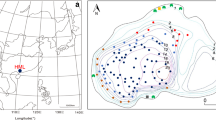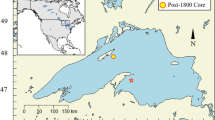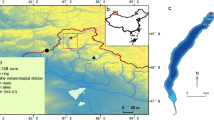Abstract
Exploring whether diatom diversity in a lake sediment core is representative of that of the entire lake is important for determining the response of lake diatom diversity to global climatic warming. In this study, Yunlong Lake, an alpine lake located in Yunnan Province, Southwest China, was investigated to explore this question over both space and time. Spatially, we investigated diatom diversity patterns in 62 surface sediment samples from different locations and depth zones of Yunlong lake and found essentially constant diatom diversity across the entire lake basin. Temporally, we studied a well-dated sediment core from the lake center to explore whether long-term water-level changes influenced diatom diversity over the last ~ 100 years. Changes in the annual average sediment accumulation rates indicate that the water level of Yunlong Lake increased substantially after the construction of a dam. However, there is no obvious relationship between diatom diversity and water-level changes, which suggests at this site long-term water-level changes did not influence diatom diversity. Comparative analysis of the results for Yunlong Lake with those for other lakes indicates that for relatively strongly mixed lakes with a simple morphology and uniform shoreline microhabitat, such as Yunlong Lake, differences in water depth and changes in water level may not influence diatom diversity. In such cases, the diatom diversity from a sediment core is likely to be representative of that of the entire lake during specific time intervals. Therefore, such lakes may be optimal for studies of changes in past diatom diversity using sediment cores.







Similar content being viewed by others
References
Adrian R, Wilhelm S, Gerten D (2006) Life-history traits of lake plankton species may govern their phenological response to climate warming. Glob Change Biol 12:652–661
Appleby PG, Oldfield F (1978) The calculation of lead-210 dates assuming a constant rate of supply of unsupported 210Pb to the sediment. CATENA 5:1–8
Battarbee RW, Kneen MJ (1982) The use of electronically counted microspheres in absolute diatom analysis. Limnol Oceanogr 27:184–188
Battarbee RW, Jones VJ, Flower BP, Cameron NG, Bennion H, Carvalho L, Juggins S (2001) Diatoms. In: Smol JP, Birks HJB, Last WM (eds) Tracking environmental change using lake sediments. Kluwer Academic Publishers, Dordrecht, pp 155–202
Beauger A, Delcoigne A, Voldoire O, Serieyssol K, Peiry JL (2015) Distribution of diatom, macrophyte and benthic macroinvertebrate communities related to spatial and environmental characteristics: the example of a cut-off meander of the river allier (france). Cryptogam Algol 36:323–355
Birks HJB (2007) Estimating the amount of compositional change in late-Quaternary pollen-stratigraphical data. Veg Hist Archaeobot 16:197–202
Birks HJB, Line JM (1992) The use of rarefaction analysis for estimating palynological richness from Quaternary pollen-analytical data. Holocene 2:1–10
Brugam RB, McKeever K, Kolesa L (1998) A diatom-inferred water depth reconstruction for an Upper Peninsula, Michigan, lake. J Paleolimnol 20:267–276
Cantonati M, Scola S, Angeli N, Guella G, Frassanito R (2009) Environmental controls of epilithic diatom depth-distribution in an oligotrophic lake characterized by marked water-level fluctuations. Eur J Phycol 44:15–29
Chen G, Dalton C, Leira M, Taylor D (2008) Diatom-based total phosphorus (TP) and pH transfer functions for the Irish Ecoregion. J Paleolimnol 40:143–163
Chen G, Saulnier-Talbot E, Selbie DT, Brown E, Schindler DE, Bunting L, Leavitt PR, Finney BP, Gregory-Eaves I (2011) Salmon-derived nutrients drive diatom beta-diversity patterns. Freshw Biol 56:292–301
Chen X, Chen G, Lu H, Liu X, Zhang H (2015) Long-term diatom biodiversity responses to productivity in lakes of Fuxian and Dianchi. Biodivers Sci 23:89–100 (in Chinese with English abstract)
Douglas MSV, Smol JP, Blake WJ (1994) Marked post-18th century environmental change in high Arctic ecosystems. Science 266:416–419
Gregory-Eaves I, Beisner BE (2011) Palaeolimnological insights for biodiversity science: an emerging field. Freshw Biol 56:2653–2661
Grimm EC (1987) CONISS, a Fortran 77 program for stratigraphically constrained cluster analysis by the method of incremental sum of squares. Comput Geosci 13:13–35
Hayford BL, Caires AM, Chandra S, Girdner SF (2015) Patterns in benthic biodiversity link lake trophic status to structure and potential function of three large, deep lakes. PLoS ONE 10(1):e0117024
Hayashi T (2011) Monospecific planktonic diatom assemblages in the Paleo-Kathmandu Lake during the middle Brunhes Chron: Implications for the paradox of the plankton. Palaeogeogr Palaeoclimatol Palaeoecol 300:46–58
Heinsalu A, Luup H, Alliksaar T, Nõges P, Nõges T (2008) Water level changes in a large shallow lake as reflected by the plankton: periphyton-ratio of sedimentary diatoms. Hydrobiologia 599:23–30
Hill MO (1973) Diversity and evenness: a unifying notation and its consequences. Ecology 54:427–432
Hoagland KD, Peterson CG (1990) Effects of light and wave disturbance on vertical zonation of attached microalgae in a large reservoir. J Phycol 26:450–457
James FC, Rathburn S (1981) Rarefaction, relative abundance, and diversity of avian communities. Auk 98:785–800
Jones GP, Mccormick MI, Srinivasan M, Eagle JV (2004) Coral decline threatens fish biodiversity in marine reserves. Proc Natl Acad Sci USA 101:8251–8253
Karabanov E, Williams D, Kuzmin M, Sideleva V, Khursevich G, Prokopenko A, Solotchina E, Tkachenko L, Fedenya S, Kerber E (2004) Ecological collapse of Lake Baikal and Lake Hovsgol ecosystems during the Last Glacial and consequences for aquatic species diversity. Palaeogeogr, Palaeoclimatol, Palaeoecol 209:227–243
Kingsbury MV, Laird KR, Cumming BF (2012) Consistent patterns in diatom assemblages and diversity measures across water-depth gradients from eight Boreal lakes from north-western Ontario (Canada). Freshw Biol 57:1151–1165
Krammer K, Lange-Bertalot H (1986–1991) Bacillariophyceae. Süsswasserflora von Mitteleuropa, Band 2. Spektrum Akademischer Verlag, Heidelberg, Berlin.
Laird KR, Cumming BF (2008) Reconstruction of Holocene lake level from diatoms, chrysophytes and organic matter in a drainage lake from the Experimental Lakes Area (northwestern Ontario, Canada). Quat Res 69:292–305
Laird KR, Kingsbury MV, Cumming BF (2010) Assessment of diatom species habitats, species diversity and depth-inference models across multiple transects in Worth Lake, northwestern Ontario, Canada. J Paleolimnol 44:1009–1024
Laird KR, Kingsbury MV, Lewis CM, Cumming BF (2011) Diatom-inferred depth models in 8 Canadian boreal lakes: inferred changes in the benthic: planktonic depth boundary and implications for assessment of past droughts. Quat Sci Rev 30:1201–1217
Lake P, Palmer MA, Biro P, Cole J, Covich AP, Dahm C, Gibert J, Goedkoop W, Martens K, Verhoeven J (2000) Global Change and the Biodiversity of Freshwater Ecosystems: Impacts on Linkages between Above-Sediment and Sediment Biota. Bioscience 50:1099–1107
Lande R (1996) Statistics and partitioning of species diversity, and similarity among multiple communities. Oikos 76:5–13
Leira M, Filippi ML, Cantonati M (2015) Diatom community response to extreme water-level fluctuations in two Alpine lakes: a core case study. J Paleolimnol 53:289–307
Lindenschmidt K, Chorus I (1998) The effect of water column mixing on phytoplankton succession, diversity and similarity. J Plankton Res 20:1927–1951
Litchman E, Klausmeier CA, Miller JR, Schofield O, Falkowski PG (2006) Multi-nutrient, multi-group model of present and future oceanic phytoplankton communities. Biogeosciences 3:585–606
Lotter AF, Bigler C (2000) Do diatoms in the Swiss Alps reflect the length of ice-cover? Aquat Sci 62:125–141
Mackay AW, Battarbee RW, Flower RJ, Granin NG, Jewson DH, Ryves DB, Sturm M (2003) Assessing the potential for developing internal diatom-based transfer functions for Lake Baikal. Limnol Oceanogr 48:1183–1192
Mann DG (1999) The species concept in diatoms. Phycologia 38:437–495
Menéndez R, González MA, Hill J, Braschler B, Willis S, Collingham Y, Fox R, Roy DB, Thomas C (2006) Species richness changes lag behind climate change. Proc R Soc B 273:1465–1470
Moos MT, Laird KR, Cumming BF (2005) Diatom assemblages and water depth in Lake 239 (Experimental Lakes Area, Ontario): implications for paleoclimatic studies. J Paleolimnol 34:217–227
Parmesan C, Yohe GW (2003) A globally coherent fingerprint of climate change impacts across natural systems. Nature 421:37–42
Pilskaln CH, Johnson TC (1991) Seasonal signals in Lake Malawi sediments. Limnol Oceanogr 36:544–557
Poister D, Kurth A, Farrell AM, Gray S (2012) Seasonality of Aulacoseira ambigua abundance and filament length: biogeochemical implications. Plankton Benthos Res 7:55–63
Pounds JA, Fogden MP, Campbell JH (1999) Biological response to climate change on a tropical mountain. Nature 398:611–615
Punning JM, Puusepp L (2007) Diatom assemblages in sediments of Lake Juusa, Southern Estonia with an assessment of their habitat. Hydrobiologia 586:27–41
Root TL, Price J, Hall KR, Schneider SH, Rosenzweig C, Pounds JA (2003) Fingerprints of global warming on wild animals and plants. Nature 421:57–60
Rühland KM, Smol JP (2005) Diatom shifts as evidence for recent Subarctic warming in a remote tundra lake, NWT, Canada. Palaeogeogr Palaeoclimatol Palaeoecol 226:1–16
Rühland KM, Paterson AM, Smol JP (2015) Lake diatom responses to warming: reviewing the evidence. J Paleolimnol 54:1–35
Simpson EH (1949) Measurement of diversity. Nature 163:688
Smol JP (1981) Problems associated with the use of species diversity in paleolimnological studies. Quat Res 15:209–212
Smol JP, Cumming BF (2000) Tracking long-term changes in climate using algal indicators in lake sediments. J Phycol 36:986–1011
Smol JP, Wolfe AP, Birks HJ, Douglas MSV, Jones VJ, Korhola A, Pienitz R, Rühland K, Sorvari S, Antoniades D, Brooks SJ, Fallu M, Hughes M, Keatley BE, Laing TE, Michelutti N, Nazarova L, Nyman M, Paterson AM, Perren B, Quinlan R, Rautio M, Saulnier-Talbot E, Siitonen S, Solovieva N, WeckstrÖm J (2005) Climate-driven regime shifts in the biological communities of arctic lakes. Proc Natl Acad Sci USA 102:4397–4402
Stevenson RJ, Stoermer EF (1981) Quantitative differences between benthic algal communities along a depth gradient in lake Michigan. J Phycol 17:29–36
Stevenson RJ, Hill BH, Herlihy AT, Yuan LL, Norton SB (2008) Algae-P relationships, thresholds, and frequency distributions guide nutrient criterion development. J N Am Benthol Soc 27:783–799
Stone JR, Fritz SC (2004) Three-dimensional modeling of lacustrine diatom habitat areas: Improving paleolimnological interpretation of planktic : benthic ratios. Limnol Oceanogr 49:1540–1548
Thomas CD, Cameron A, Green RE, Bakkenes M, Beaumont LJ, Collingham YC, Erasmus BFN, Siqueira MF, Grainger A, Hannah L, Hughes L, Huntley B, Jaarsveld AS, Midgley GF, Miles L, Ortega-Huerta MA, Peterson AT, Phillips OL, Williams SE (2004) Extinction risk from climate change. Nature 427:145–148
Tolotti M, Corradini F, Boscaini A, Calliari D (2007) Weather-driven ecology of planktonic diatoms in Lake Tovel (Trentino, Italy). Hydrobiologia 578:147–156
Wagner C, Adrian R (2011) Consequences of changes in thermal regime for plankton diversity and trait composition in a polymictic lake: a matter of temporal scale. Freshw Biol 56:1949–1961
Wang H, Yang Z, Saito Y, Liu JP, Sun X (2006) Interannual and seasonal variation of the Huanghe (Yellow River) water discharge over the past 50 years: connections to impacts from ENSO events and dams. Glob Planet Change 50:212–225
Wang H, Yang Z, Saito Y, Liu JP, Sun X, Wang Y (2007) Stepwise decreases of the Huanghe (Yellow River) sediment load (1950–2005): Impacts of climate change and human activities. Glob Planet Change 57:331–354
Wang L, Lu H, Liu J, Gu Z, Mingram J, Chu G, Li J, Rioual P, Negendank JF, Han J (2008) Diatom-based inference of variations in the strength of Asian winter monsoon winds between 17,500 and 6000 calendar years BP. J Geophys Res 113:1–9
Wang L, Li J, Lu H, Gu Z, Rioual P, Hao Q, Mackay AW, Jiang W, Cai B, Xu B (2012a) The East Asian winter monsoon over the last 15,000 years: its links to high-latitudes and tropical climate systems and complex correlation to the summer monsoon. Quat Sci Rev 32:131–142
Wang L, Rioual P, Panizzo VN, Lu H, Gu Z, Chu G, Yang D, Han J, Liu J, Mackay AW (2012b) A 1000-yr record of environmental change in NE China indicated by diatom assemblages from maar lake Erlongwan. Quat Res 78:24–34
Winder M, Schindler DE (2004) Climatic effects on the phenology of lake processes. Glob Change Biol 10:1844–1856
Winder M, Reuter JE, Schladow SG (2009) Lake warming favours small-sized planktonic diatom species. Proc R Soc B 276:427–435
Wolin JA, Stone JR (2010) Diatoms as indicators of water-level change in freshwater lakes. In: Stoermer EF, Smol JP (eds) Diatoms applications to the environmental and earth sciences. Cambridge University Press, Cambridge, pp 174–185
Worm B, Barbier EB, Beaumont N, Duffy JE, Folke C, Halpern BS, Jackson JBC, Lotze HK, Micheli F, Palumbi SR, Sala E, Selkoe KA, Stachowicz JJ, Watson R (2006) Impacts of biodiversity loss on ocean ecosystem services. Science 314:787–790
Xu K, Milliman JD (2009) Seasonal variations of sediment discharge from the Yangtze River before and after imp- oundment of the Three Gorges Dam. Geomorphology 104:276–283
Xu F, Tao S, Dawson RW, Li P, Cao J (2001) Lake ecosystem health assessment: indicators and methods. Water Res 35:3157–3167
Yan Y, Wang L, Li J, Li J, Zou Y, Zhang J, Li P, Liu Y, Xu B, Gu Z, Wan X (2018) Diatom response to climatic warming over the last 200 years: a record from Gonghai Lake, North China. Palaeogeogr Palaeoclimatol Palaeoecol 495:48–59
Zou Y, Yan Y, Zhang J, Zhang L, Wang L (2015) The relationship between water depth and diatom diversity of Yunlong Lake, Yunnan Province. Quat Sci 35:988–996 (in Chinese with English abstract)
Zou Y, Wang L, Zhang L, Liu Y, Li P, Peng Z, Yan Y, Zhang J, Lu H (2018) Seasonal diatom variability of Yunlong Lake, southwest China–a case study based on sediment trap records. Diatom Res 33:381–396
Acknowledgements
We are grateful to the Administration Bureau for Tianchi National Nature Reserve for their assistance and support during field work. We also thank Dr. Jan Bloemendal for polishing the manuscript. This study was funded by the National Key R&D Program of China (Award 2017YFA0603400), the Strategic Priority Research Program of Chinese Academy of Sciences (Award XDB26000000), and the National Natural Science Foundation of China (award 41772379).
Author information
Authors and Affiliations
Corresponding author
Additional information
Publisher's Note
Springer Nature remains neutral with regard to jurisdictional claims in published maps and institutional affiliations.
Electronic supplementary material
Below is the link to the electronic supplementary material.
Rights and permissions
About this article
Cite this article
Zou, Y., Wang, L., Xu, H. et al. Do changes in water depth and water level influence the diatom diversity of Yunlong Lake, in Yunnan Province, Southwest China?. J Paleolimnol 64, 273–291 (2020). https://doi.org/10.1007/s10933-020-00137-x
Received:
Accepted:
Published:
Issue Date:
DOI: https://doi.org/10.1007/s10933-020-00137-x




